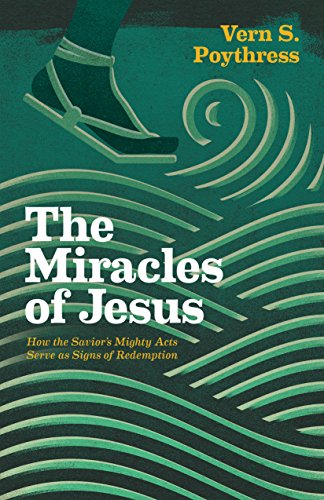A Brief Book Summary from Books At a Glance
By Clay Werner
About the Author
Vern S. Poythress (PhD. Harvard University; ThD. Stellenbosch University) is professor of New Testament Interpretation at Westminster Theological Seminary and has written numerous books.
Overview
This book seeks to provide an interpretive method for understanding and applying the miracles of Jesus in the book of Matthew. Part I introduces miracles while explaining what they are and why they are significant. They are supernatural actions of God which reveal the identity of Jesus as the Son of God and as the awaited Messiah. They also reveal the redemptive purposes of God, inviting others to place their trust in him. Part II explores miracles as ‘signs’ that foreshadow and point to the resurrection while also pointing to deeper spiritual realities and the consummated kingdom. As supernatural works of God, they fit into and further the larger pattern of redemption that God had begun in the Old Testament and will fulfill in the eschaton.
Dr. Edmund Clowney’s interpretive triangle to better understand typology is explained and adapted for use with the miracles which are shown to have larger circles of meaning, ultimately connecting not only to creation but to the re-creation of all things. Part III uses the previous interpretive grid that was formulated to chronologically walk through every miracle in Matthew’s gospel and apply it to believers. Poythress concludes in part IV by showing that the interpretive grid utilized to understand the miracles of Matthew can also be used to understand all of the miracles mentioned throughout scripture and can specifically apply to particular needs of believers as they walk by faith.
Table of Contents
Part I: INTRODUCING MIRACLES
1 The Reality of the Miracles of Jesus
2 The Significance of Miracles
Part II: MIRACLES AS SIGNS
3 Illustrative Miracles from the Gospel of John
4 The Pattern of Redemption
5 The Pattern of Application of Redemption
6 Typological Reasoning about Miracles
7 Broader Implications of the Miracles of Jesus
8 Specific Applications
Part III: MIRACLES IN MATTHEW
9 The Virgin Birth (Matt. 1:18–25)
10 The Baptism of Jesus (Matt. 3:13–17)
11 Many Healings (Matt. 4:23–25)
12 Cleansing a Leper (Matt. 8:1–4)
13 The Centurion’s Servant (Matt. 8:5–13)
14 Peter’s Mother-in-Law (Matt. 8:14–17)
15 Calming a Storm (Matt. 8:23–27)
16 The Gadarene Demoniacs (Matt. 8:28–34)
17 Healing a Paralytic (Matt. 9:1–8)
18 Raising Jairus’s Daughter (Matt. 9:18–26)
19 Healing Two Blind Men (Matt. 9:27–31)
20 Healing a Mute Demoniac (Matt. 9:32–34)
21 Many Healings (Matt. 9:35–38)
22 Healing a Withered Hand (Matt. 12:9–14)
23 Many Healings (Matt.12:15–21)
24 A Blind and Mute Man (Matt. 12:22–23)
25 Feeding the 5,000 (Matt. 14:13–21)
26 Walking on Water (Matt. 14:22–33)
27 Healing Many (Matt. 14:34–36)
28 The Syrophoenician Woman (Matt. 15:21–28)
29 Healing Many (Matt. 15:29–31)
30 Feeding 4,000 (Matt. 15:32–39)
31 The Transfiguration (Matt. 17:1–8)
32 A Boy with a Demon (Matt. 17:14–20)
33 The Coin in the Fish’s Mouth (Matt. 17:24–27)
34 Many Healings (Matt. 19:2)
35 Two Blind Men at Jericho (Matt. 20:29–34)
36 Cursing the Fig Tree (Matt. 21:18–22)
Part IV: THE RESURRECTION OF CHRIST AND ITS APPLICATION
37 The Resurrection of Jesus (Matt. 28:1–10)
38 Applications to Particular Needs
Conclusion
Appendix: Miracles in the Whole Bible
Summary
PART I
INTRODUCING MIRACLES
Chapter 1: The Reality of the Miracles of Jesus
Questions about miracles are ultimately about two things: the existence of God and what kind of God exists. As opposed to a materialistic, mechanistic worldview, the Bible reveals that God acts to create and then sustains the world he created. This sustaining of the universe provides regularities that are the foundation of science. In addition to this, God is also personal which means that he can cause exceptions to the regularities when he wills. Another issue that arises is the credibility of the miracles in the Gospels. It must be understood that the writers did claim to be writing about actual history and that the books possess divine authority as they witness to the historical events during the life of Jesus- the Son of God, promised in the Old Testament prophecies. In the pursuit of truth, the reader must come to the Gospels asking God to reveal himself as one reads.
Chapter 2: The Significance of Miracles
Miracles are not simply strange events but are works of God that reveal his purposes. Many in the gospels saw Jesus’ work as that of a prophet in which the miracles attested to God’s power and his authenticity to show he was truly called of God. Through his work, they knew God was doing something new, inviting not only those who existed in ancient times, but also those who exist in modern times to place their trust in Jesus. His miracles were ‘signs’- truths concerning God, Christ, and the salvation he brought- that have permanent meaning.
[To continue reading this summary, please see below....]The remainder of this article is premium content. Become a member to continue reading.
Already have an account? Sign In
